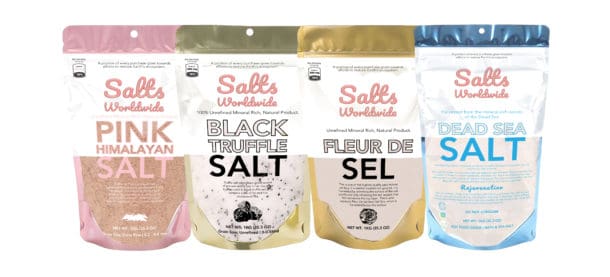There are a variety of Himalayan mountain salt benefits. It contains three times as much potassium as regular table salt, making it a healthy choice for respiratory ailments. Pink Himalayan salt contains a lower level of iodine than table salt, which makes it a good choice for people with low iodine requirements.
Pink Himalayan salt contains three times as much potassium as regular table salt
Salt is essential for life and well-being. Animals often seek out salt beyond the food they consume. In fact, animal meats have more sodium than plant-based foods. As agriculture began to spread across the world, people also looked for external salt sources. Pink Himalayan salt is one of these sources because it contains no plastic or chemicals.
Pink Himalayan salt is also rich in magnesium, a mineral that our bodies need. It helps regulate blood sugar levels and helps maintain nerve function. Additionally, it helps prevent high blood pressure. It also contains a healthy dose of iron, a mineral that many people are lacking.
The minerals present in pink salt were studied using descriptive statistics. One-way analyses of variance were performed to identify the differences in mineral content by color intensity and form. Two-sample t-tests were also performed to determine differences in mineral content between the pink salt and a control salt. The statistical analyses were conducted with Minitab 17 and SAS University Edition.
The benefits of pink salt over regular table salt are numerous. In addition to being less processed than ordinary table salt, it contains more potassium than sea salt. It also has fewer sodium, which is crucial for fluid balance and muscle regulation. Regular table salt is 98% sodium chloride, while pink salt contains only 2% of the same substance.
Pink Himalayan salt is a popular alternative to ordinary table salt. Its pink hue makes it look more appealing to cook with and is considered a healthier alternative to table salt. While it contains more potassium than regular table salt, it is not significantly different from regular salt in terms of nutrition. However, too much salt can lead to high blood pressure, heart disease, and stroke.
It helps clear mucus
The use of Himalayan mountain salt to clear mucus has many health benefits. It is known for its healing properties and has been used for thousands of years in India. Its healing properties date back to Ayurvedic medicine. It is now gaining popularity in the western world.
The salt’s anti-inflammatory properties help clear mucus. It also has antibacterial and antiviral properties, making it an excellent natural remedy for the common cold. It is rich in iron and helps relieve cough and other bronchial congestion. The salt can be ingested or used as an inhaler.
Himalayan salt is a natural, drug-free solution to respiratory problems. It is made from 100% pure rock salt crystals. It helps reduce the symptoms of cold and other respiratory ailments, but is not a cure. People should consult their doctor before using Himalayan salt.
Besides being a healthy alternative to processed salt, Himalayan mountain salt is also rich in nutrients and minerals. It is mined in the foothills of the Himalayas and has 84 trace elements. It helps balance electrolytes in the body and eases muscle cramps. In addition, it strengthens bones because it contains calcium.
It is low in iodine
Himalayan mountain salt is low in ions and sodium, and can lower blood pressure. Its low iodine and high mineral content make it an excellent alternative to table salt, which is highly processed and often contains fewer minerals. It is also a natural source of iodine, which is essential for a healthy body, as it helps regulate electrolyte balance and promotes nutrient absorption.
While natural rock salt contains iodine, man-made table salt contains iodide, which depletes the body of the essential mineral. Studies have linked iodide to thyroid, neurological, and metabolic diseases. Additionally, people who have a high intake of table salt have an increased risk of developing thyroid, pancreas, and metabolic problems.
While pink Himalayan salt contains trace minerals, it is low in iodine and is therefore suitable for human consumption. It also has a unique flavor compared to table salt. People prefer it for cooking, serving, and finishing dishes.
Choosing the right salt for your needs is a personal decision. Many people use specialty salts with more nutrients and less sodium. But which is best? This is largely a matter of personal preference, but you can find Himalayan mountain salt online and at health food stores. It’s available in fine grinds and looks beautiful in a shaker.
Himalayan pink salt is an excellent choice for your diet, as it improves your health. It has antibacterial and antimicrobial properties, and it can be used to treat respiratory problems and chest congestion.
It is used to treat respiratory ailments
Using a Himalayan mountain salt inhaler is an effective way to relieve congestion and flush mucus out of the respiratory tract. It also detoxifies the body. In addition, the salt has a soothing effect on the respiratory system and can improve sleeping habits. In fact, salt therapy has also been used to alleviate snoring.
Himalayan mountain salt is known for its antibacterial and antimicrobial properties. When inhaled, the particles help clean the respiratory system and help relieve respiratory ailments such as seasonal allergies and chest congestion. It also provides relief for sinusitis and bronchitis. The benefits of Himalayan salt have been documented in several studies, including a 2006 article in the New England Journal of Medicine and a 1996 article in the European Respiratory Journal.
One of the most affordable ways to get salt therapy is to use a Himalayan salt inhaler. These salt inhalers are made of 100% natural rock salt crystals and are an effective way to experience the benefits of salt therapy at home. These salt inhalers are safe and effective for anyone of any age, and are a great alternative to traditional drugs. The advantages of using Himalayan mountain salt inhalers are many.
Salt therapy, which is also known as halotherapy, is a technique that recreates the conditions of a salt cave. It is an alternative treatment that is 100% natural and safe and offers long-term relief. The Himalayan crystal salt used in this method is naturally antibacterial, antifungal, anti-viral, and anti-microbial. The salt particles help clean the respiratory system by clearing air passages. They also thin mucus and absorb allergens and toxins.
In addition to being a good alternative to traditional medicines, Himalayan salt can be used for home remedy purposes. Some people use it to treat respiratory ailments, such as asthma and bronchitis. It can also improve a person’s health and alleviate stress.
It is expensive
While Himalayan mountain salt is highly regarded for its mineral content, it is also incredibly expensive. The process of mining the salt is considered the main cause for its price. The salt is extracted by hand from mines free of pollution. It is also marketed as having flavorful and luxurious properties.
While it is not as cheap as common table salt, Himalayan salt has become a hot commodity in the gourmet market. In early 2019, British grocer Tesco reported that its sales of Himalayan salt rose by 2000% in just one year. The demand for gourmet salt may have been spurred by the Coronavirus pandemic, increasing household spending on home cooking. The company said that gourmet salt now accounts for 40 percent of its overall salt sales.
One of the biggest challenges facing the salt industry is the high demand for the product. In the past, people in the Himalayan mountains traded Himalayan salt for grain and other commodities. This practice continues in modern times. Historically, salt was used as a form of currency, and the salt remains valuable in the region. In fact, the salt is used as currency in Nepal. It does not grow very well in the foothills, so it is traded for grains.
It has become increasingly difficult for Pakistan to access and process Himalayan salt, as a result of a lack of processing facilities. Until recently, Pakistan exported Himalayan salt to India at $40 per ton. Since then, India began selling it in the global marketplace for $300 per ton. In 2019, however, the Pakistani government banned the trade of rock salt with India, crippling the export-oriented salt industry in the country.



